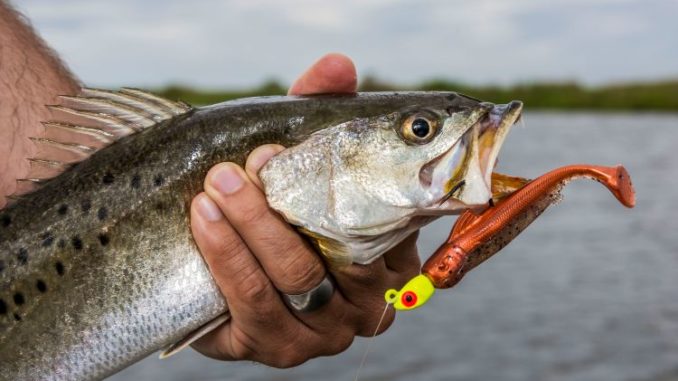
Deep bayou bends hold scads of specks right now
Speckled trout are invading inshore waters across the coast, and you can definitely build limits by drifting open-water bays. However, there’s a better way to fill your box with specks — but this tactic will only last a few more weeks.
A Thursday (April 27) trip to the marshes surrounding New Orleans yielded a limit of trout well before noon. In fact, I was driving home with the fish cleaned and bagged by 12:30 p.m. — and no live bait was harmed all day long.
The key is to find points in bayous where the current has scoured out deep holes. Trout stack up along the ledges close to shallow water, feeding on croakers lallygagging along those drop-offs.
Boat positioning is important: You want to anchor up on the point, literally pushing up as shallow as you can get. We usually anchored with our bow on the banks when we stopped at a point.
Then you simply fish out the back and sides of the boat, making long casts to the middle of the bayou.
But if your lure isn’t making it to the bottom, the odds of catching trout are about as good as the Cubs winning the World Series. Wait, they did that last year — but you get the point.
Here’s what you need:
• 3/8-ounce jigheads
• Paddle-tail plastic cocahoes (we used Matrix Shads, but other brands like Yum Mud Minnows work, too)
• A medium-heavy rod
• Braided line (not absolutely necessary, but you’ll understand in a few minutes why it matters)
• Fluorocarbon leader
The jighead weight ensures you touch the bottom with your bait. Just cast as far into the bayou as possible, and then strip a bit of extra line out to allow the lure plenty of slack to hit the bottom quickly.
Then reel up the slack, move the rod tip to the 12 o’clock position to pick the lure off the bottom and let the plastic sink back down.
Although hard snaps might trigger bites, it’s really a matter of working the lure slowly. My bites came by easing the rod tip up.
If you’re not feeling oysters, you are either not on the bottom or you need to move. The hard bottom holds the croakers that attract the specks.
And this is not a deal where the trout are jerking the rod out of your hand: The bites can be extremely subtle, very similar to fishing plastics for bass. If you feel a thump, it’s pretty likely you’re feeling a trout spitting the lure.
Instead, pay close attention to what the lure feels like. If you suddenly don’t feel the bottom, set the hook. If your lure feels heavier, set the hook. And if you think you’re hung in grass, set the hook.
Those strikes usually seems to happen when your rod tip is between 10 and 12, leaving little room for the hook set — and that’s why a medium-heavy rod and braid are beneficial, since the stiffness of the rod and lack of line stretch allow you to stick fish quickly.
I caught a lot of trout on my trip using a medium-action rod, but my fishing partner for the day didn’t have to snatch his rod behind his head because he was using a stiffer rod. He definitely had an easier time of it.
That’s it. Sometimes the fish will be on the bottom in the deepest part of the bayou’s swing, other times they will be on the ledge. Just ensure you cover the entire area well to steadily build a box full of springtime specks.


